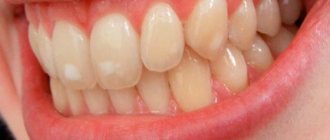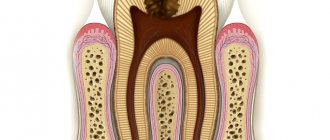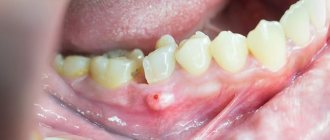Why did gumboil appear after dental treatment?
Swelling of the gums indicates the occurrence of an inflammatory process, which caused the complication. If painful sensations are observed against the background of the tumor, the main reasons for this may be:
- Periodontal inflammation. The tumor is observed on both cheeks, but pronounced swelling occurs only on the infected side.
- Neglected teeth, improper placement of fillings. Before swelling occurs, pain occurs. After 2-3 days, a flux with pus may form.
- Incorrect development of wisdom teeth. A hood forms from the mucous membrane, in which food particles accumulate and become inflamed.
- Removal of a tooth. Due to mechanical damage to the tissue, swelling can be considered normal.
- Cyst. The inflammatory process lasts for 1.5-2 years and injures the periosteum. The pathology occurs against a background of severe pain.
Attention! Swelling of the cheek after dental treatment can develop due to infection in the socket, which not only causes discomfort and swelling, but can also lead to more serious consequences.
If there is no pain during swelling, the reasons for this are as follows:
- allergic reaction to anesthesia, dental materials (swelling sometimes affects the entire face);
- removal of the nerve: part of the nerve may remain in the canals; after installation of the filling, flux appears;
- dissection of the gums, extracted tooth (in these cases, swelling is normal);
- infectious inflammation of the lymph in children, accompanied by aches and fever;
- neurological diseases accompanied by swelling, congestion in the ears, sore throat, weakness.
Important! In the case of severe pathologies of internal organs, the drainage of fluid is often disrupted; as a result, it accumulates in the nose, cheeks, neck, cheekbones and near the eyes.
How long does the flux last after tooth extraction?
Many patients wonder why the flux does not go away after tooth extraction. The answer to this question is obvious: if the infection has penetrated deep into the tissue and an inflammatory process has developed, tooth extraction is unlikely to stop it. If the pathology arose immediately after extraction, then you should not expect that the problem will disappear on its own. Of course, there are situations when the initial inflammation goes away due to the protective properties of the body. However, gumboil is a result, not a start, so it practically cannot disappear on its own, even if it breaks through on its own and some of the pus comes out. Moreover, neglected periostitis develops into an abscess and phlegmon, which are even more difficult to cure. The most serious consequences of flux are blood poisoning and death, which often happened in the past when medicine did not have effective treatment methods.
What does flux look like?
It is of infectious origin, the process occurs against the background of inflammation of the body of the jaw or in the periosteum. Flux is formed not only after dental surgery, but also after furunculosis or tonsillitis. If the cheek and gums are swollen, there is throbbing or mild pain, in advanced stages pus may appear and the temperature may rise. On the upper jaw, the flux covers the lip, cheek, gum and nasolabial area. In addition to the face, the infection often spreads to the neck.
Anti-inflammatory and antibacterial drugs are used for treatment. After using topical medications, you should not eat or drink liquids for 2 hours.
What is baby tooth flux?
Periostitis is a purulent lesion of the periosteum. It contributes to the formation of an abscess and the appearance of severe toothache. It can be acute or chronic.
The acute form of the disease is difficult to miss - a lump appears on the child’s gum, filled with purulent masses. As a result, the cheek may “swell” and the cervical lymph nodes often become enlarged.
Chronic flux on a baby tooth often does not manifest itself at all. But at the same time, it has a destructive effect on the child’s jaw and causes negative changes in the functioning of his immune system. It is a consequence of incompletely cured acute periostitis, pulpitis, periodontitis or trauma.
Swelling on the inside of the cheek
Anesthesia makes tooth extraction easier. But, if after treatment of a tooth your cheek is swollen, you should find out the origin of the pathology. You may need treatment for your gums. Discomfort appears in many patients after depulpation. Pain and swelling on the inside of the cheek can be observed from 2 hours to 7 days. If discomfort intensifies or occurs 2 days after surgery, you should immediately consult a dentist.
If, after removing the nerve, in addition to painful sensations, the gums become inflamed, purulent discharge appears, and the temperature rises, you should visit a dentist. He will find out why the cheek is swollen and how to remove the gumboil.
Attention! You cannot take painkillers and anti-inflammatory drugs before consulting a doctor; this will complicate the diagnosis, which will not allow you to prescribe adequate treatment.
Why does pathology develop?
The development of a purulent-inflammatory process is provoked by bacteria that penetrate the tissue before the extraction procedure (i.e., tooth extraction), during or after it. Let's look at each scenario in more detail.
Advanced dental diseases before the extraction procedure
It often happens that the patient already had gumboil, his tooth was removed, but the tumor remained. That is, initially a person came to dentistry with an acute or chronic inflammatory process that arose against the background of advanced caries, pulpitis or periodontitis. Doctors carried out extraction, antiseptic treatment of the hole and its curettage (cleaning), opened the abscess, and prescribed antibiotics. And if the patient does everything correctly, in accordance with the recommendations, then the flux gradually goes away, but this does not happen instantly, because the inflammation has been present in the tissues for a long time.
If, after pulling out a tooth, you ignore medical recommendations, then the gumboil does not go away or even becomes larger.
2. Unprofessional actions of the doctor during extraction
If flux appears after tooth extraction, this may be due to a violation of asepsis during the surgical operation. The specialist could have carried out poor quality sanitation of the hole and introduced an infection inside. The problem can be caused by the presence of fragments or remnants of roots, filling material, or instrument fragments in the tissues.
Important! To avoid the formation of cheek flux after tooth extraction and other complications, it is necessary to monitor the work of a doctor. At the final stage of the surgical operation, professional dental surgeons must take an x-ray (especially if the extraction procedure was complex and it was necessary to use a bur, extracting the root in parts). An X-ray examination allows you to check whether there are any fragments left in the socket that can cause inflammation. For more information about whether you need to take an x-ray after extraction, read the feature article on the website.
Failure to comply with recommendations during the rehabilitation period
Flux is one of the common complications that arise due to neglect of the following recommendations in the first 2–4 days:
- active chewing of food on the side of the jaw where the intervention took place, eating irritating foods (hard, hot, spicy),
- direct impact on a socket that has not yet healed: active rinsing, damage with a brush, tongue, finger, or foreign objects. As a result, a protective clot disappears from the wound, which prevents bacteria from penetrating inside,
- drinking alcohol and smoking,
- refusal to take medications and antibiotics prescribed by a dentist,
- applying warm compresses, warming the cheeks, visiting the sauna and steam room, physical activity, long stays in the open sun,
- complete lack of oral hygiene.
What to do if swelling appears after treatment at the dentist
If after tooth extraction your cheek is swollen from the tooth, there is no need to worry - this is a normal reaction. You can take a pain reliever that your dentist recommends. When a pathological condition is accompanied by pain and weakness, the temperature should be measured.
Edema does not always indicate a complication; it is worth distinguishing a simple reaction of the body from a pathological condition. Don't worry if:
- the flux disappears 3 days after surgery;
- the swelling is not pronounced and does not increase in size;
- no temperature or it does not exceed 37.5 degrees;
- the pain is aching, slight, gradually goes away, eliminated with analgesics;
- in the hole there is a bloody dense clot, which is covered with fibrous tissue within 2-3 days.
On a note! Do not apply hot lotions to the injured area, release pus yourself, or massage the gums. This will provoke further development of the infection, which will lead to serious consequences.
The following symptoms indicate complications:
- the flux grows;
- there is severe pain that cannot be relieved with analgesics;
- tension together with surgery;
- temperature over 37.5-37.6 degrees;
- it hurts to swallow, speak, open your mouth;
- there is no blood clot in the hole or it is covered with a green, gray or yellow coating;
- unpleasant odor from the mouth;
- itching, hyperemia, shortness of breath - indicate an allergic reaction.
Attention! If you have any of the symptoms, you should consult your doctor. Such signs indicate infection. If an operation was performed, the treatment is carried out by a dental surgeon or an endodontist if the root canals were cleaned.
How long does the flux last after extraction?
At first after removal, an inflamed and painful state is considered a normal reaction of the body. However, in situations where the infection penetrates deeply into the tissue structure, provoking pathological processes, even extraction of the problem unit does not guarantee relief of the negative syndrome.
Flux is the result of the development of the disease, and not its root cause, which makes it difficult to eliminate the pathology. Even with an independent breakthrough of suppuration, accompanied by the release of exudate, the resulting cavity can cause the development of an abscess or phlegmon, the treatment of which requires much more effort. In the most severe forms of development, flux leads to infection of the circulatory system, and, as a result, death.
When does swelling of the cheek go away?
How long the swelling lasts after tooth treatment depends on the degree of damage. Swelling causes injury to tissues, ligaments, and blood vessels during surgery or root removal. After such an intervention, swelling is normal. It can last from 2 hours and last for 7 days or the first day after surgery. There are no painful sensations.
Swelling after surgery on a wisdom tooth can last 4 days longer and persists for 11 days. If the surgery was serious, a bruise may form on the cheek. Pronounced swelling, increasing every day, pain is a reason to urgently consult a dentist.
Recommendations for treatment and prevention
How long does the flux last after tooth extraction if treatment is started in a timely manner? In the early stage, symptoms disappear within two to three days. In severe forms (large purulent gum after tooth extraction), when surgical intervention is required, rehabilitation takes longer and takes up to several weeks. What is important is how the patient follows the doctor’s recommendations and what measures he takes to speed up recovery.
Prohibited!
- self-medicate and self-prescribe antibiotics;
- apply warm compresses and use warming ointments, as this promotes the growth of bacteria;
- take aspirin before surgery, as it thins the blood;
- During the recovery process, active physical activity, going to the sauna and swimming pool are prohibited (even when the jaw no longer hurts).
Flux after wisdom tooth removal occurs much more often, since the procedure for removing “eights” is usually very traumatic, which affects the condition of the soft tissues. After the removal of wisdom teeth, you need to especially carefully monitor your condition and take all necessary preventive measures to minimize the risk of developing periostitis.
How to treat gumboil on the cheek
Once a tumor develops, antibiotics are often indispensable. The dentist selects them taking into account the stage of the pathology and the characteristics of the body. Antibiotic therapy should be completed to the end, otherwise further treatment will be greatly complicated.
If surgery is required, all activities are carried out in a dental clinic. For any complication, the patient is given local or general anesthesia. The gum is incised and the accumulated pus is completely pumped out. A drainage is placed to quickly remove fluid. The patient is prescribed antibiotics to allow the soft tissues to recover faster. In case of severe damage, the gum is sutured. In the absence of complications, this is not required.
How to remove swelling from the gums through surgery:
- In case of complicated flux, urgent hospitalization in a dental clinic and an operation performed by a dental surgeon are necessary.
- If an inflammatory process is diagnosed due to dental problems, endodontic therapy (cleaning and filling the canals) or root removal will be required.
- Broad-spectrum antibiotics are prescribed to treat infection in many situations. In case of serious complications, combination drugs are used to treat severe swelling, selected taking into account the sensitivity of the pathogens.
- Surgical treatment - incision of the abscess (on the face and oral cavity - the incision is made in both areas), removal of purulent discharge, treatment with disinfectants, installation of drainage. In severe cases, general anesthesia is used.
- Additional therapy - analgesics to eliminate discomfort, antipyretic drugs, large amounts of fluid (if necessary, fluid is introduced into the body by infusion during hospitalization).
Chronic pathology often occurs without pronounced symptoms, pus appears gradually. In this situation, the dentist uses a therapeutic approach, both surgical and conservative. Surgery can be replaced with herbs or antibiotics, or used as an additional treatment after consultation with a specialist.
Swelling of the cheek does not always indicate the presence of a serious pathology.
A tumor after depulpation is normal and does not require serious treatment. When the gumboil gradually grows, pain is observed against this background, and the help of a dentist is required. In case of serious complications, surgical intervention while taking antibiotics is indicated. The doctor's consultation
How to eliminate cheek swelling
It is impossible to get rid of edema 100% before the inflammatory process stops. To reduce discomfort and pain, you can apply cooling compresses for 7-10 minutes with a break of 30-40 minutes. Taking painkillers, baths and rinsing with soothing solutions at room temperature helps.
How to remove cheek swelling after tooth extraction at home
- Avoid contact with the hole. It should not be touched with the tongue, brushed, or allowed to get in contact with food.
- Adhere to dietary restrictions. You should not eat or drink for 4 hours after removal. In the next week, food should be soft, at room temperature, not hot or spicy. Eating sweets is not advisable.
- In the first 3-4 hours after removal, apply cooling compresses to the cheek. It is optimal to keep the compress for 3-5 minutes, maximum – 10-15. The compress can only be done on the first day.
- Rinse your mouth with an antiseptic solution. The main thing is to follow all the dentist’s instructions.
What to do with flux - treatment features
It is important for parents to remember: if a child’s illness appears, they must be shown to an experienced dentist. Attempts to open an abscess on your own can only aggravate the situation and lead to blood poisoning. The only thing is, if you can’t consult a doctor right away today, you can rinse the affected tooth with water and soda or salt. Also suitable for these purposes are pharmaceutical antiseptics designed specifically for treating the mucous membranes of the oral cavity.
The dentist always decides how best to deal with gumboil, taking into account the condition of the gums and the age of the patient. If the affected tooth is about to fall out, it is removed immediately. There is no point in stressing out a child by trying to save a unit that is about to leave the dentition anyway.
If we are talking about a tooth that the patient must live with for several more years, then conservative treatment is most often carried out. It is preferred to avoid crooked teeth in the future. Indeed, often when a tooth is pulled out prematurely, “neighbors” take its place. Because of this, the permanent unit then begins to erupt to the side, and it has to be put in place with the help of complex orthodontic treatment.
Conservative therapy involves opening a purulent neoplasm. The formed cavity is drained and washed with an antiseptic composition. If necessary, a drainage tube is installed in the gum for a while to avoid the re-formation of a purulent “bump”.
After such a procedure, special attention is paid to therapeutic rinses. The baby may even be prescribed antibiotics or anti-inflammatory drugs.
Flux prevention
Flux on the gums is easier to prevent than to treat. Unfortunately, it is impossible to insure against the disease, but following some recommendations will reduce the likelihood of developing gumboil:
- Teach your child to maintain oral hygiene.
- Visit your dentist twice a year for a checkup.
- Monitor the condition of your teeth: prevent the development of caries and other dental pathologies. At the first symptoms, consult a doctor.
- Choose a toothbrush with soft or medium bristles.
- Limit your consumption of sweets - the main cause of tooth decay.
In the clinics of the Center of Israeli Dentistry in the Dnieper (metro station Livoberezhnaya) and Darnitsky (metro station Osokorki, Poznyaki) areas, your child will be provided with all the necessary services for the treatment, diagnosis and prevention of dental diseases. Dentistry has long been painless, and we follow modern standards of treatment. Your child will feel at ease and comfortable with our doctors.
How to recognize flux in baby teeth in children
Among the main symptoms of the disease are:
- the appearance of an abscess on the gum at the base of the tooth crown;
- the occurrence of aching pain from the inflammatory reaction;
- pronounced swelling of the cheek;
- increased body temperature;
- general weakness, lethargy;
- the appearance of bad breath;
- enlargement of the lymph node located on the side of inflammation.
The flux makes the child feel unwell. He becomes capricious, whiny, and refuses to eat.











